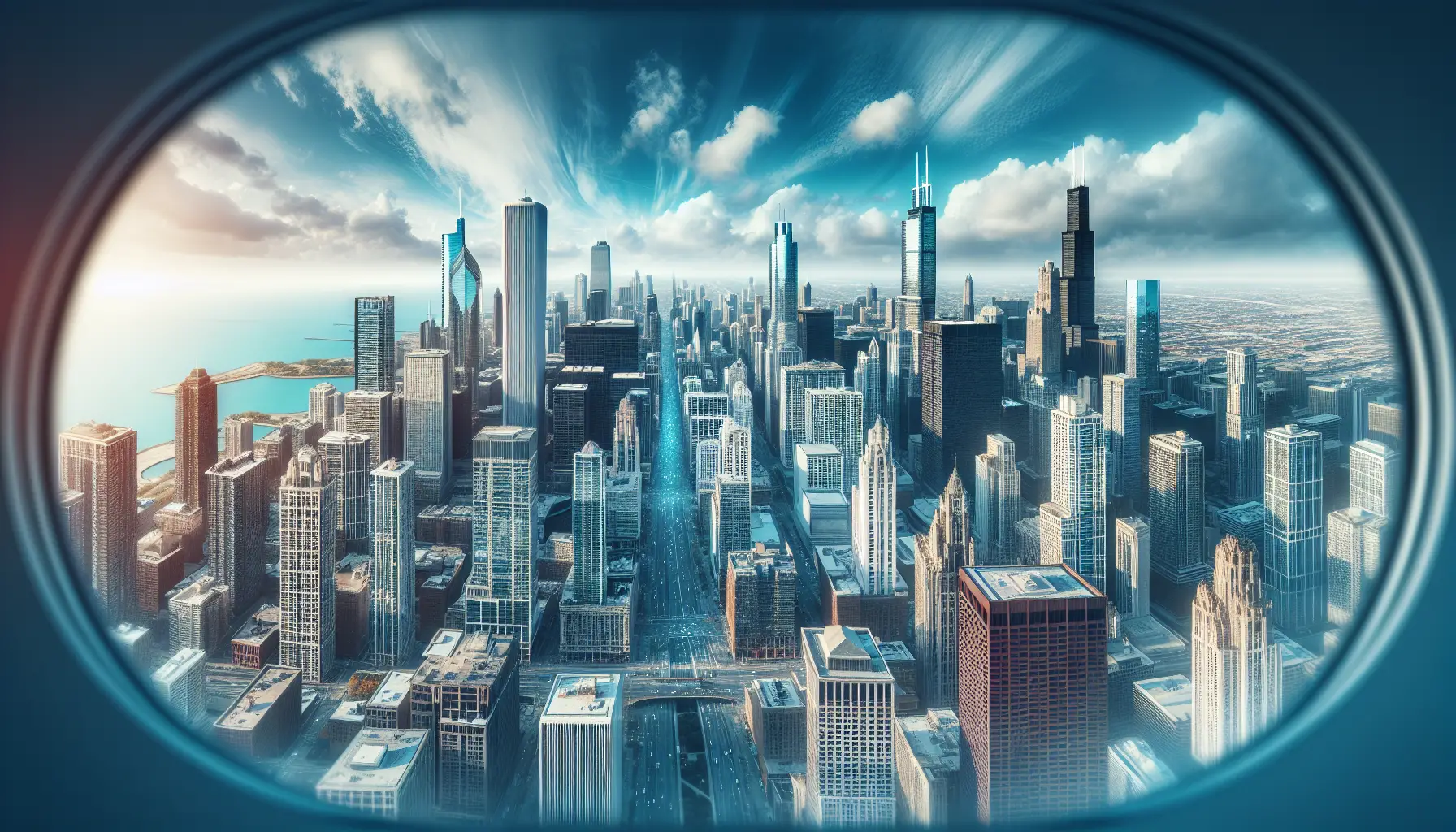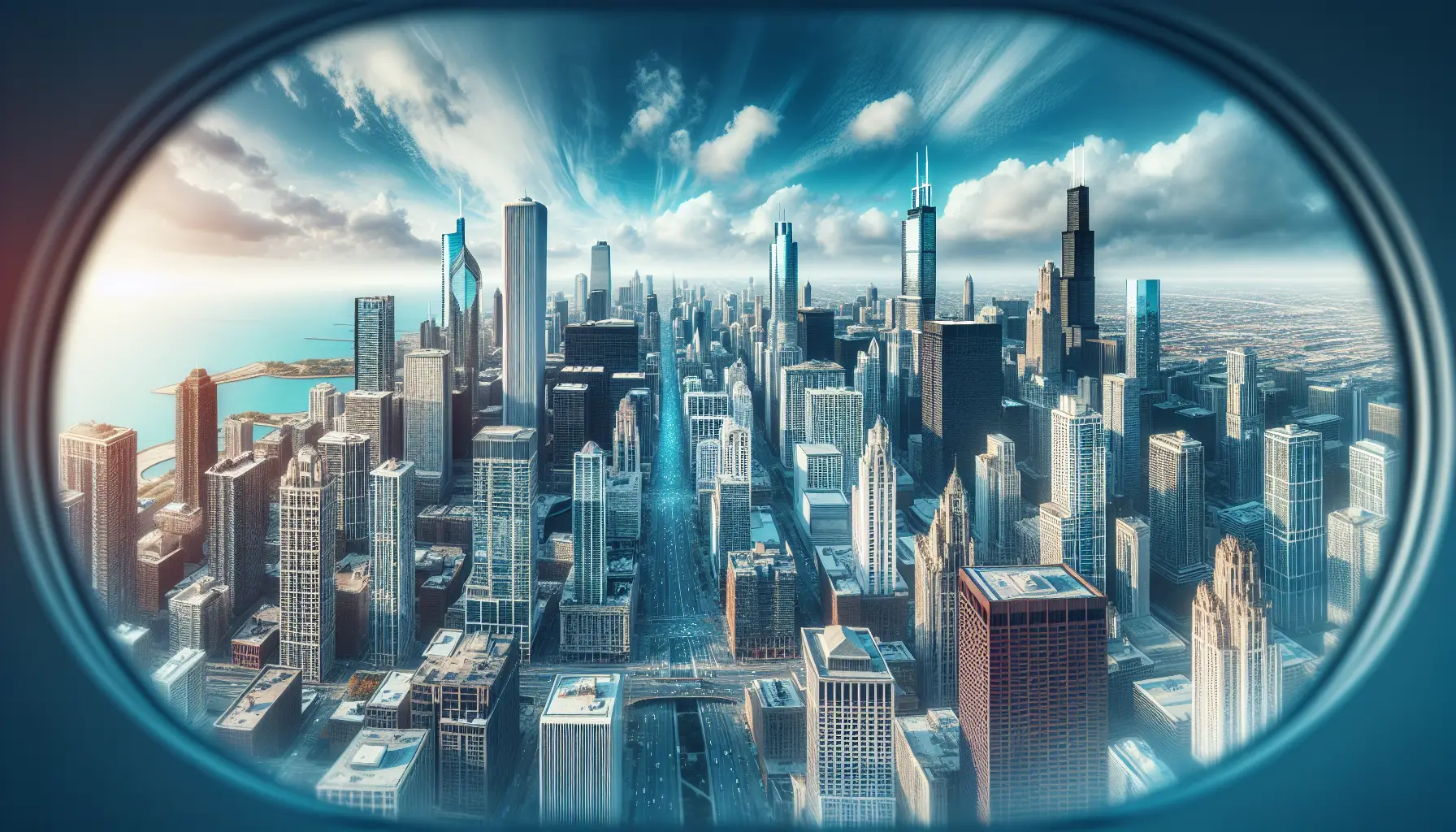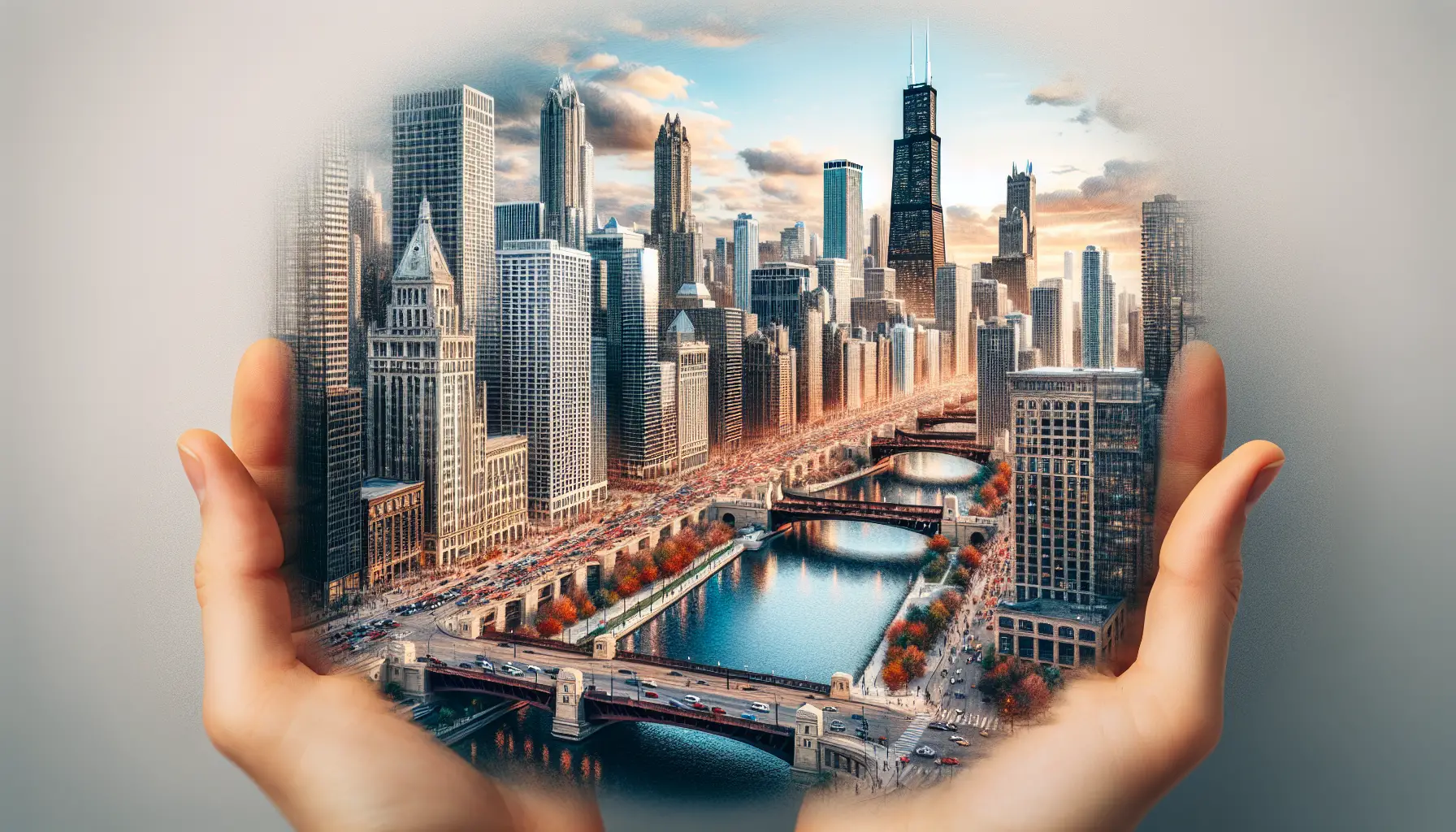Chicago, the Windy City, is a vibrant metropolis that holds many wonders and accolades. From its stunning architectural marvels, such as the iconic Willis Tower, to its deep-rooted history and connection to jazz and blues music, Chicago is a city that exceeds expectations. Renowned for its mouthwatering deep-dish pizza and the beloved Chicago-style hot dogs, this city is a food lover’s paradise. With its stunning lakefront, prominent museums like the Art Institute, and remarkable sports teams, Chicago has undoubtedly earned its place in the hearts of locals and visitors alike. So, what exactly is Chicago best known for? Let’s take a closer look.
Click to see ALL the Avialable Attraction in Chicago
Architectural Marvels
Chicago is renowned for its breathtaking architectural marvels that define its iconic skyline. One of the standout structures that immediately captures the eye is The Willis Tower, formerly known as the Sears Tower. This towering skyscraper held the title of the tallest building in the world for 25 years until it was surpassed in 1998. The Willis Tower stands at a staggering height of 1,450 feet and offers visitors breathtaking views from its Skydeck observation deck.
Another architectural gem in Chicago is the Chicago Water Tower. Built in 1869, this historic landmark is one of the few surviving structures from the Great Chicago Fire of 1871. The visually striking castle-like design of the water tower adds a touch of elegance to the cityscape.
The Tribune Tower is yet another architectural gem that captures the attention of locals and visitors alike. This neo-Gothic style skyscraper serves as the headquarters for the Chicago Tribune newspaper and is known for its unique exterior adorned with fragments of famous buildings from around the world, including the Parthenon, the Great Wall of China, and the Taj Mahal.
Not to be missed is Millennium Park, a modern architectural masterpiece that seamlessly blends art, architecture, and nature. Within the park lies Cloud Gate, a mirrored sculpture affectionately known as “The Bean.” Its reflective surface captures the surrounding skyline and creates a playful distortion of reality, making it a favorite spot for visitors to snap photos and immerse themselves in the beauty of the city.
Deep-Dish Pizza
When it comes to culinary delights, Chicago is most renowned for its deep-dish pizza. This unique style of pizza is characterized by its deep, buttery crust, filled to the brim with a generous portion of cheese, sauce, and various toppings. Originating in the mid-20th century, deep-dish pizza has become a quintessential symbol of Chicago’s food culture.
Famous pizzerias in Chicago have perfected the art of deep-dish pizza, each with their own twist and variations. Giordano’s is an iconic establishment known for its decadent deep-dish pizza, which boasts a thick crust and layers upon layers of cheese. Lou Malnati’s is another beloved name on the Chicago pizza scene, famous for its signature buttery crust and tangy tomato sauce.
When it comes to toppings, Chicago offers a wide variety to suit every palate. From traditional choices like sausage, pepperoni, and mushrooms to more adventurous options like spinach and ricotta, deep-dish pizza in Chicago is a culinary adventure in itself.
Sports Legacy
Chicago is a city defined by its passion for sports, and its teams have left an indelible mark on the city’s sports legacy. Starting with baseball, the Chicago Cubs and the Chicago White Sox are two historic teams that have captivated fans for generations.
The Chicago Cubs have a storied history and are known for their dedicated and loyal fan base. Wrigley Field, the team’s home since 1916, is one of the oldest ballparks in the country and offers a nostalgic charm that adds to the experience of watching a Cubs game.
The Chicago White Sox, on the other hand, have their own devoted fan base and boast a rich history. Guaranteed Rate Field, their home stadium, provides a modern and vibrant atmosphere for cheering on the team.
Moving to basketball, the Chicago Bulls are synonymous with greatness thanks to their dominance in the 1990s. Led by the legendary Michael Jordan, the Bulls won six championships and became a global phenomenon, forever etching their place in the city’s sports history.
In American football, the Chicago Bears are a beloved institution. Known for their passionate fan base and gritty playing style, the Bears have a strong following and have had some memorable seasons in their rich history.
When it comes to ice hockey, the Chicago Blackhawks have a legacy of success. With multiple Stanley Cup victories in recent years, the Blackhawks have solidified themselves as one of the NHL’s premier teams.
Lastly, in the realm of soccer, the Chicago Fire have made their mark in Major League Soccer. Since their establishment in 1997, the Fire have won numerous titles and have cultivated a loyal fan base.
Blues and Jazz Music
Chicago is hailed as the birthplace of blues and jazz music, contributing significantly to the evolution of these iconic genres. The city’s rich musical heritage has shaped the cultural fabric of Chicago and continues to resonate throughout its vibrant music scene.
Both blues and jazz originated in the early 20th century, drawing inspiration from the city’s African American community and the Great Migration. The blues, with its soulful melodies and expressive lyrics, became a powerful form of musical expression, connecting deeply with listeners.
Chicago’s famous blues and jazz clubs are a testament to the city’s musical heritage. The world-renowned Buddy Guy’s Legends showcases some of the finest blues musicians, offering an intimate and authentic experience for visitors. The Green Mill Cocktail Lounge, a historic jazz club dating back to the 1900s, welcomes patrons with its vintage atmosphere and live performances that transport you back in time.
Prominent musicians who have emerged from Chicago’s blues and jazz scene include legends such as Muddy Waters, B.B. King, Louis Armstrong, and Ella Fitzgerald. Their contributions to the genres have left an indelible mark on music history, solidifying Chicago’s reputation as a hub of musical excellence.
The Magnificent Mile
If you’re looking for a shopper’s paradise, then look no further than Chicago’s Magnificent Mile. This famed stretch of Michigan Avenue is a bustling shopping district that features an impressive array of luxury retailers, iconic landmarks, and must-visit attractions.
The Magnificent Mile offers a diverse range of shopping experiences, from flagship department stores like Macy’s and Neiman Marcus to high-end designer boutiques like Louis Vuitton and Gucci. With its world-class shopping options, it’s no wonder that the Magnificent Mile ranks as one of the top shopping destinations in the United States.
In addition to its shopping allure, the Magnificent Mile is home to many notable landmarks and attractions. The historic Wrigley Building, with its striking white facade, stands as a testament to Chicago’s architectural prowess. The John Hancock Center, a towering skyscraper, offers breathtaking views of the city from its observation deck. The Chicago Water Tower, a survivor of the Great Chicago Fire, serves as a reminder of the city’s resilience.
With its mix of luxury retailers, impressive architecture, and cultural landmarks, the Magnificent Mile is a must-visit destination for anyone seeking a truly unforgettable Chicago experience.
Art and Culture
Chicago’s vibrant art and culture scene is a testament to the city’s creative spirit and commitment to artistic expression. From world-class museums to renowned theaters and orchestras, Chicago offers a wealth of cultural experiences that celebrate the arts in all their splendor.
The Art Institute of Chicago is a true gem in the city’s cultural landscape. With its extensive collection of artworks spanning thousands of years, the institute showcases masterpieces from both renowned artists and emerging talents. Visitors can marvel at iconic works like Grant Wood’s “American Gothic” and Georges Seurat’s “A Sunday on La Grande Jatte.”
The Chicago Theater is another iconic landmark that celebrates the performing arts. With its grand marquee and luxurious interior, the theater is a must-see for theater enthusiasts. From Broadway shows to live performances by world-class musicians, the Chicago Theater offers a diverse range of entertainment options.
For classical music aficionados, the Chicago Symphony Orchestra is a revered institution. With its exceptional musicians and acclaimed conductors, the orchestra delivers awe-inspiring performances that showcase the beauty and power of symphonic music.
Chicago’s vibrant comedy scene is epitomized by The Second City, a renowned improvisational comedy club. Many comedy legends, including Tina Fey and John Belushi, got their start at The Second City. The club continues to attract talented performers who deliver side-splitting shows that leave audiences in stitches.
The Great Chicago Fire
The Great Chicago Fire of 1871 is a pivotal event in the city’s history that forever changed its landscape. The fire, which started in a barn and quickly spread, destroyed much of Chicago’s central business district and residential areas, leaving thousands homeless and causing widespread devastation.
The Great Chicago Fire had a profound impact on the city, leading to significant changes and transformations. In the aftermath of the fire, Chicago rose from the ashes, undergoing a period of rapid rebuilding and reconstruction. Architects seized the opportunity to create innovative new designs, resulting in the birth of Chicago’s iconic skyscrapers.
The fire also prompted the establishment of the Chicago Fire Department, which played a pivotal role in preventing future disasters and ensuring the safety of the city’s residents. The Chicago Fire Academy, the training center for the fire department, stands as a testament to the city’s commitment to fire safety and preparedness.
Though the Great Chicago Fire was a devastating tragedy, it ultimately symbolizes the resilience and determination that define Chicago as a city.
Ethnic Diversity and Culture
Chicago’s rich ethnic diversity is a testament to its vibrant cultural tapestry and the lasting impact of immigration throughout its history. The city has attracted people from all corners of the globe, creating a melting pot of cultural traditions and communities.
The historical wave of immigration in the late 19th and early 20th centuries brought various ethnic communities to Chicago, seeking opportunities and a better life. These communities left an indelible mark on the city’s cultural landscape, shaping neighborhoods that still reflect their heritage today.
Chinatown is a vibrant neighborhood in Chicago that showcases Chinese culture and cuisine. With its colorful streets, ornate architecture, and authentic eateries, Chinatown offers a captivating glimpse into a different world. Visitors can explore unique cultural enclaves, browse through traditional markets, and savor delicious dim sum.
Little Italy, once a bustling hub for Italian immigrants, has preserved its distinctive charm and heritage. Strolling through the streets, visitors can savor delectable Italian cuisine, indulge in authentic gelato, and witness the remnants of Italian culture that continue to thrive.
Greektown is another neighborhood that invites visitors to immerse themselves in Greek culture. From Greek festivals and vibrant restaurants to stunning Byzantine-style churches, Greektown captures the essence of Greek traditions and hospitality.
Chicago’s Mexican influence is evident in neighborhoods like Pilsen and La Villita. These vibrant communities celebrate Mexican culture through colorful murals, lively festivals, and mouthwatering Mexican cuisine. Visitors can delve into the rich tapestry of Mexican heritage and experience the warmth and vibrancy of the community.
Lastly, Chicago’s Polish community, concentrated mainly in neighborhoods like Avondale and Jefferson Park, has preserved its strong cultural traditions. Festivals like the Taste of Polonia and cultural organizations promote Polish art, music, and cuisine, offering visitors a taste of Poland in the heart of Chicago.
Lake Michigan and Beaches
Lake Michigan, one of the five Great Lakes, plays a vital role in shaping Chicago’s identity and attraction as a city. Its proximity to the lake provides Chicagoans and visitors alike with endless opportunities for outdoor recreation and relaxation.
Lake Michigan’s importance goes beyond its picturesque beauty. The lake serves as a source of drinking water for the city and provides a unique ecosystem that supports diverse wildlife.
The Lakefront Trail, a scenic pathway that stretches for 18 miles along Lake Michigan, offers stunning views and is a popular spot for jogging, cycling, and leisurely walks. As you explore the trail, you can witness the splendor of the lake’s crystal-clear waters, with sailboats dotting the horizon.
North Avenue Beach, located at the northern end of the Lakefront Trail, is a favorite destination for beachgoers. With its golden sands, vibrant beach volleyball courts, and iconic skyline backdrop, North Avenue Beach offers the perfect setting for a day of sun and relaxation.
Montrose Beach, situated on the city’s North Side, is another popular beach destination that offers a more serene atmosphere. Surrounded by natural dunes and abundant birdlife, Montrose Beach provides visitors with a tranquil escape from the bustling city.
Whether you’re seeking thrilling water sports, a leisurely stroll along the shore, or simply a peaceful retreat, Lake Michigan and Chicago’s beaches offer a multitude of options to satisfy your waterfront cravings.
Transportation Hub
As a major transportation hub, Chicago boasts key transport infrastructure that connects the city to the world and ensures seamless travel for residents and visitors alike.
O’Hare International Airport stands as one of the largest and busiest airports in the world. Serving millions of passengers every year, O’Hare offers an extensive network of domestic and international flights, connecting Chicago to destinations across the globe. Its state-of-the-art facilities and efficient services have earned it numerous accolades and continue to make it a vital gateway to the city.
Chicago Union Station, a historic landmark, serves as a hub for train travel in Chicago and beyond. With its iconic Beaux-Arts architecture, the station offers a grand entrance to the city for travelers arriving by rail. From Union Station, Amtrak trains connect Chicago to various destinations throughout the United States, providing a convenient and scenic way to explore the country.
Within the city, the Chicago Transit Authority (CTA) operates an extensive network of buses and trains that serve the various neighborhoods and suburbs. The “L” train system, characterized by its elevated tracks, is an iconic symbol of Chicago’s transportation infrastructure. The CTA’s efficient services offer residents and visitors an accessible and convenient way to navigate the city’s many attractions.







